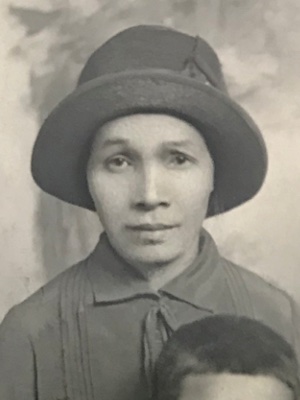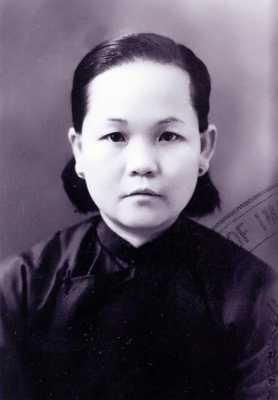Chinese graves at Melbourne General Cemetery
Discover their Chinese names and places of origin
Contents: Ernest Leong Gie | Shee Leong (also known as Shee Hoy Leong) | Mary Young | Henry Fook Shing | Ah Mon | Credits
Stories about the people at the cemetery
Read about the people who have been interred at the Melbourne General Cemetery. They have ordinary and extraordinary lives. They are people striving to create a better life for themselves and their families.
Ernest Leong Gie
Ernest’s ancestral village was Doong Hing, Kaiping County, Guangdong Province. He was the eldest of five brothers. He arrived in Melbourne in 1899 when he was about 16 years of age. He worked as a fruit merchant, market gardener and then as a cabinet maker until the early 1920s. Ernest embraced Christianity in the early 1900s and eventually became the minister at the Chinese Methodist Church at 196 Little Bourke Street Melbourne in the mid-1920s. He returned to his ancestral village to get married in 1905, also visiting in 1909 and 1921. Unusual at that time in China, he ensured his three daughters were all well-educated. In 1928 his wife Shee Leong (also known as Shee Hoy Leong) and their young son left China to join him in Melbourne. Ernest was a hardworking devout Christian leader and was renowned for his stern preaching both inside the church and in the open air in Little Bourke Street. On his own initiative he opened a Christian school in Guangdong Province. Ernest also taught many young people to read and write Chinese in the upstairs hall of the church on weeknights. He remained the highly respected minister of the Chinese Methodist Church until he retired in late 1954.
By Derek Leong
Learn more about Ernest from the headstone.
Shee Leong (also known as Shee Hoy Leong)
Shee’s ancestral village was Hiuhook, Kaiping County, Guangdong Province. Her family name was Hoy and her family were rice merchants in the town of Shu Hou (or “Suiho”) across the river from Gung Yek, Kaiping County, Guangdong Province. She had four siblings. She married Ernest Leong Gie in about 1905 and lived in his ancestral village of Doong Hing, Kaiping County, Guangdong Province, which was about one hour from Hiuhook village. She gave birth to three daughters and one son between 1906 and 1922. In 1928, Shee and her son left Doong Hing to join her husband at the Chinese Methodist Church at 196 Little Bourke Street Melbourne, where he was the minister. Later, two of her three daughters also emigrated to Melbourne. Shee fully supported her husband in his Christian work and looked after her extended family and many others with much kindness and care. She had a very happy disposition and was greatly admired and loved by her family and friends.
By Derek Leong
Learn more about Shee Leong from her headstone.
Mary Young
Mary Young/Wong Ho 黃女好 (1912 -1953) came to Australia from China in 1948. She joined her husband William Ah Young, a market gardener in Coburg. Mary had four children. Her oldest daughter was married and stayed in China. Two other daughters came with her in 1948. One daughter was born in Australia. Mary worked at the market garden to help the family business and raise her children. In China, Mary was raised in a family of high social status and hence she found life in Australia difficult. Sadly, she passed away in 1953 from complications of appendicitis.
William Ah Young and family visit the grave.
By Terry Young
Learn more about Mary Young from her headstone.
Henry Fook Shing
Henry Fook Shing was a renown Melbourne Chinese detective in Victoria’s police force. He travelled from Guangdong via Hong Kong to Australia in the 1850s gold rush period and became a local “headman” with the Chinese community on the Bendigo goldfields. In the 1860s, when the Chinese left the goldfields, Fook Shing came to Melbourne’s Chinatown and was appointed to the Victoria Police. As a Chinese speaking migrant, he was able to easily mix with the local Chinese in gambling houses and opium dens in Little Bourke St. He was highly regarded and trustworthy and he made many successful arrests in the Chinese community. Fook Shing had a colourful life on and off duty.
At the Melbourne General Cemetery, he was been buried with his wife (Ellen Fook Sing).
Learn more about Henry Fook Shing from the headstone.
Image: Melbourne Illustrated – In the Chinese Quarter, Graphic, November 13 1880. State Library of Victoria
Reference: Benjamin Wilson Mountford - Friday essay: the story of Fook Shing, colonial Victoria’s Chinese detective https://theconversation.com/friday-essay-the-story-of-fook-shing-colonial-victorias-chinese-detective-94017
Ah Mon
Ah Mon first came to Australia in 1898 via Western Australia and resided there for 23 years. In 1923, he travelled to Victoria and lived in Yarrawonga, Mildura and Wangaratta until 1934. His main occupation during his life in Australia was as a market gardener. He travelled back to China in 1912 and 1929. He had two sons in China. From 1934 to 1957, he resided in Melbourne, working as a cook. Ah Mon is a member of the Woon (溫) family clan. He is related to a number of other family clan members buried at the Melbourne General cemetery.
“Our family would visit his grave at the Melbourne General Cemetery. Only in recent times did we discover that he was a relative and hence supported my father when he first migrated to Australia.”
By Terry Young
Credits
- Chinese Australian Family Historians of Victoria (www.cafhov.com)
- Terry Young - Website development and photography
- Anna Wolf - Transcription of headstone inscriptions
Contributions/Support by
- Sophie Couchman
- Linda Wong
- Andrew Huang
- John Griffiths
- Derek Leong
- Jeremy Hunt
- Carly Peters
- Southern Metropolitan Cemetery Trust
This digital collection is built with CollectionBuilder, an open source framework for creating digital collection and exhibit websites that is developed by faculty librarians at the University of Idaho Library following the Lib-Static methodology.







